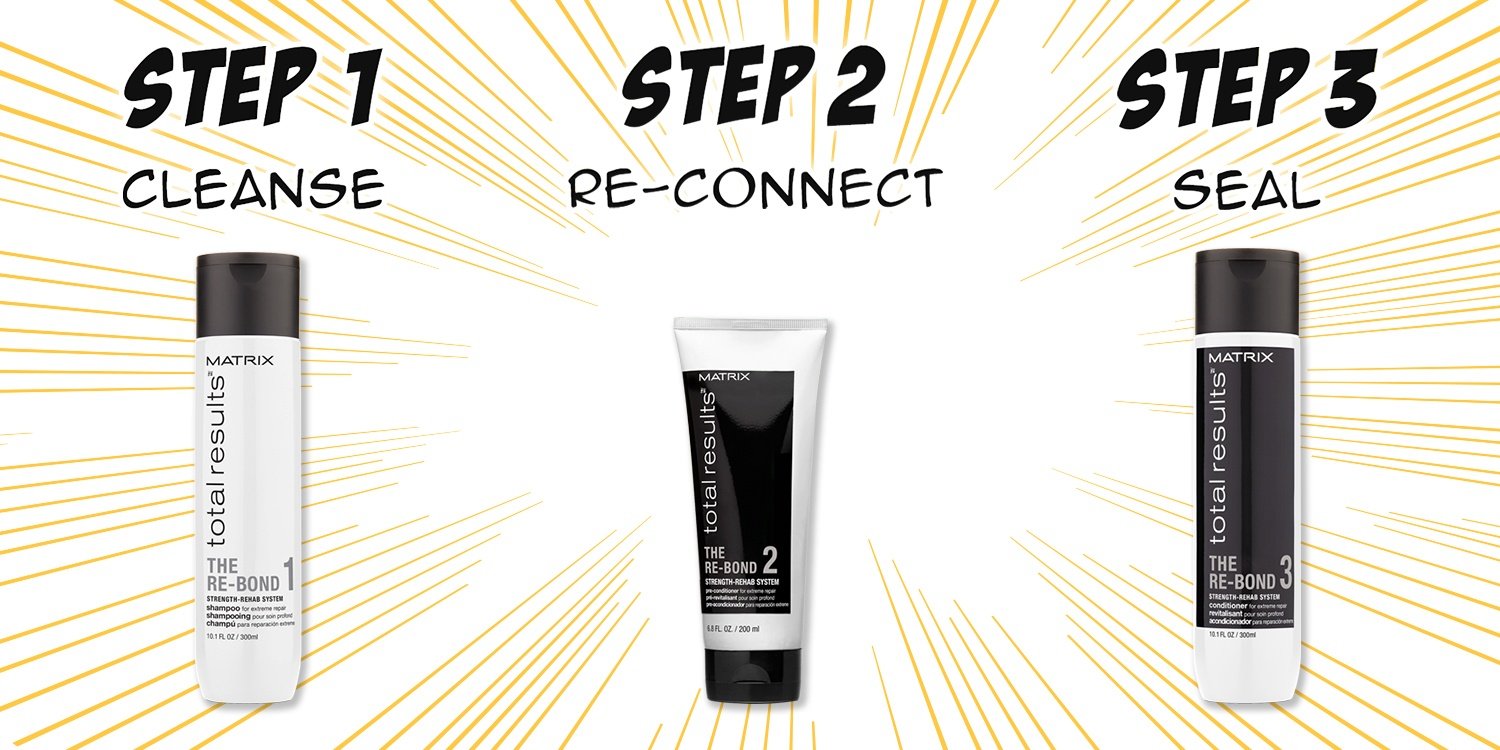How To Repair Your Damaged Hair In 3 Easy Steps

In today’s world, there are so many ways to change up your hair. It’s fun! It’s exciting! It’s a cool way to express yourself! But there’s a downside to all of those new looks and new hair colors—namely, extreme hair damage. Does that mean you have to stop having fun with your hair? Absolutely not! Thanks to some groundbreaking new technology from Total Results, you can now repair your broken and extremely damaged hair in three easy steps. Here’s the scoop.
It’s All About the Hair Bonds
The science and research pros at Matrix explain things this way. At the root of damaged hair is the condition of the hair bonds. To understand hair bonds, it’s helpful to understand the essential structure of the hair. Everyone’s hair is composed of protein. Protein is composed of amino acids. Coils of these amino acids link together to form chains that are called polypeptide chains. Polypeptide chains form bonds with one another, and it’s these bonds that hold the hair together.
There are two types of bonds. Hydrogen and salt bonds are the weaker of the two types. They are also the most common. The structure of these bonds can be altered with water or heat. So when you wind your hair around your curling iron, the hydrogen and salt bonds rearrange themselves to temporarily form your bouncy curls.
Disulfide or cystine bonds are the second type of bonds. These bonds are the strongest, and they account for your hair’s strength and elasticity, which is the ability of your hair to resume a normal shape after it is stretched. These bonds can be broken with chemical processes like texturizing services, lightener or hair color. This type of bond breakage is permanent, and it leads to tragic experiences like broken hair and split ends.
Three Clues That Your Hair is Extremely Damaged
So how do you know if your hair bonds are broken? Aside from the obvious visuals of dryness, limpness, lifelessness and hair breakage, here are a few specific indicators.
1. Roughness. Breakage along the hair strand causes the texture of your hair to feel rough rather than soft and supple. To test for hair roughness, place a small section of hair between your forefinger and thumb and slide your fingers from top to bottom. Notice if the texture changes noticeably as you progress to the ends.
2. Brittleness. As mentioned before, elasticity is the quality that allows hair to be stretched without losing its original shape. Broken hair bonds compromise elasticity, which leads to limp, lifeless hair. To test the condition of your hair’s elasticity, isolate a single hair and gently tug on it with your thumb and forefinger. If the hair doesn’t snap back into shape, your elasticity is impaired.
3. Split ends. This one’s pretty obvious. If you look closely at your ends, and they appear branchlike instead of solid, they’re broken and split.
3 Steps to Repairing Your Broken Hair Bonds and Fixing Your Damaged Hair
Before you decide to break up with your hair colorist and return to your natural, mousy brown hair color, take heart. What would you say if not only could you repair those broken bonds, you could do so at home? The new, three-part, Total Results Re-Bond rehab system is an at-home regimen for hair that is extremely damaged from too many chemical treatments or from too much heat styling. Here’s how it works:
1. Step One—Re-Bond Shampoo. Powered by citric acid, this chelating or deep cleansing shampoo formula whisks away the abusive minerals, metals, and chlorines that build up on the hair, essentially “cleansing the canvas” for the subsequent steps. You apply it to damp hair and rinse.
2. Step Two—Re-Bond Pre-Conditioner. Infused with maleic acid, this pre-conditioner travels deep into the hair fiber to reconnect and reinforce those weakened hair bonds. Apply it after using the ReBond Shampoo, and leave it on for five minutes.
3. Step Three—Re-Bond Conditioner. Thanks to high concentrations of an acid called taurine in this conditioner formula, the final step in the Re-Bond system seals and protects each strand from the inside out, leaving hair strong, healthy and good as new! Layer it over the Pre-Conditioner and then rinse.
The creators of Total Results promise that ReBond will repair internal hair strength after damage from three previous lightening/chemical services, offering a next-generation solution for overworked hair. It can be alternated with any Total Results care and styling system, (Moisture Me Rich and So Long Damage are great choices,) and is an ideal home care follow-up after the in-salon Matrix Bond Ultim8 treatment that protects and repairs hair bonds during a hair color service.
7 Tips for Keeping Your Healed Hair Healthy
Once ReBond has healed your broken and extremely damaged hair, the pros at Matrix offer tips for keeping your hair in tip-top condition.
1. Stay Trimmed. Stop split ends before they happen by getting your hair trimmed every two to three months to keep ends healthy.
2. Detangle Like a Boss. Brushing or combing vigorously through wet hair can cause hair to snap and break if it’s tangled. Use a wide tooth comb or special detangling brush, start at the bottom and gently untangle hair section by section.
3. Sleep Dry. Sleeping on wet hair leads to tangles, and tangles lead to breakage. So if you’re an evening shower person, take the time to dry your hair before you go to bed. Or, work a nighttime hair mask through damp strands, and wind your hair into a bun for protection. Also, consider switching to a satin pillowcase to avoid the friction and snags that can stress damaged hair even more.
4. Loosen Up. Tight braids and ponytails are tough on delicate hair strands. So keep your updos, braids, ponies and messy buns as loose as possible. And always use loose-fitting hair ties, smooth clips or elastics to secure your hair; never rubber bands.
5. Shampoo Less. The rubbing motion of shampooing your hair causes friction that can cause delicate hair to break. What’s more, over-shampooing may strip your hair of the natural oils that keep it soft and supple. So scale back your shampoos as much as possible. On “no-poo” days, freshen your hair and scalp with a dry shampoo.
6. Blot, Don’t Rub. Scrubbing your hair dry with a stiff towel after shampooing is another stressor for fragile strands. Pros recommend swapping out the terry towel for an absorbent microfiber cloth and gently squeezing and blotting your wet hair.
7. Beat the Heat. Give your hair a break from blow dryers and styling irons whenever you can. Apply an air-dry crème and let your natural hair texture take shape!






